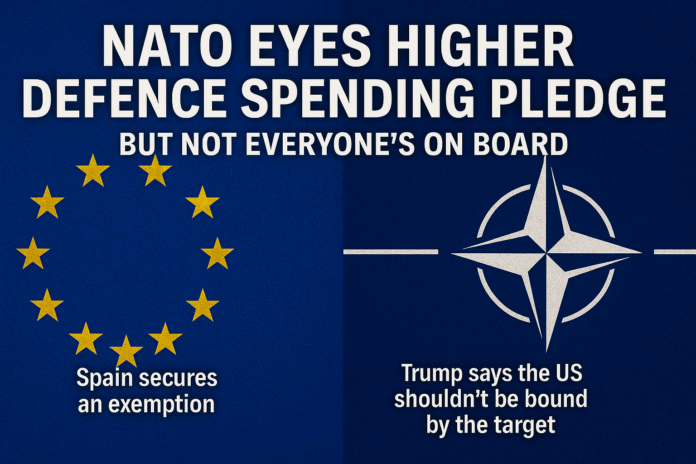BRUSSELS — As NATO prepares to unveil a major new defence spending pledge at this week’s summit, internal divisions are already emerging. The proposed plan would require each member state to commit 5% of its GDP to defence-related efforts — a dramatic increase from current levels. But not all allies are on board.
Spain has secured an exemption from the target, and U.S. President Donald Trump has declared that the benchmark should apply only to America’s partners, not the United States itself.
“I don’t think we should, but I think they should,” Trump said on Friday, criticizing Canada as “a low payer” and noting, “NATO is going to have to deal with Spain.”
A Split Approach to Shared Security
The new 5% target is expected to be introduced in a simplified, one-page summit communiqué that reportedly softens previous language requiring “all allies” to meet the goal. Instead, NATO leaders appear to be allowing for flexibility, as resistance from key members grows.
Spain’s Prime Minister Pedro Sánchez confirmed Sunday that Madrid had negotiated an opt-out from the pledge. Spain currently spends just 1.28% of its GDP on defence — the lowest rate in the alliance. Sánchez has pledged to raise this to 2.1% over time, arguing that this level is sufficient to meet NATO’s capability expectations — which focus on military contributions and roles rather than raw spending levels.
What the 5% Plan Includes
The 5% figure is split into two components:
- 3.5% of GDP for core military spending, such as personnel, equipment, and operations. This alone would be a significant jump from NATO’s long-standing 2% benchmark, which only 22 of 32 members currently meet.
- 1.5% for broader security investments, including infrastructure upgrades, cyber defence, and societal resilience — such as modernizing ports, roads, and airfields to support rapid troop movements and defending against hybrid threats.
While the second component is seen as more achievable, the 3.5% military commitment presents a steep challenge for many nations — especially those with political constraints or economic limitations.
Domestic Pressures and Political Risk
Sánchez’s decision to seek an exemption reflects political realities at home. His government is under increasing strain, relying on a fragile coalition and facing corruption allegations involving close allies. The opposition has already begun calling for early elections, limiting his room to maneuver on controversial spending decisions.
Spain is also one of Europe’s smallest contributors of military aid to Ukraine, a point that further complicates its position within the alliance.
Rising Russian Threat Drives Urgency
The push for higher spending comes amid growing concern over Russia’s ongoing war in Ukraine and a wave of hybrid threats across Europe — from cyberattacks to GPS interference and infrastructure sabotage. NATO military planners warn that defending the continent against a potential Russian offensive requires a minimum of 3% of GDP in defence investment.
Several frontline and northern European countries — including Germany, Sweden, Norway, the Netherlands, and the Baltic states — are expected to meet or exceed the 5% target. The Netherlands estimates it will need to find an additional €16–19 billion ($18–22 billion) to comply.
Spanish Foreign Minister José Manuel Albares defended his country’s stance on Monday, stating: “Spain can meet the alliance’s needs with 2.1 percent. Capability matters more than a number.”
Debate Over Timelines and Enforcement
NATO leaders are also debating how quickly members must meet the new target. A 2032 deadline has been proposed, a more aggressive timeline than past open-ended spending goals. Some nations, like Italy, are requesting a full decade to scale up their budgets, while others are pushing for quicker progress. There is also talk of a 2029 progress review and a possible extension to 2035 for lagging members.
Despite the flexibility being discussed, Trump’s message was blunt.
“We’ve carried NATO long enough,” he said. “Now it’s their turn.”










